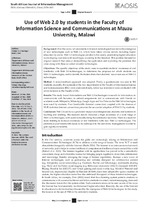| dc.contributor.author | Chawinga, Winner D. | |
| dc.contributor.author | Zinn, Sandy | |
| dc.date.accessioned | 2018-05-03T09:36:06Z | |
| dc.date.available | 2018-05-03T09:36:06Z | |
| dc.date.issued | 2016 | |
| dc.identifier.citation | Chawinga, W.D. & Zinn, S. (2016). Use of Web 2.0 by students in the Faculty of Information Science and Communications at Mzuzu University, Malawi. South African Journal of Information Management, 18(1): a694. | en_US |
| dc.identifier.issn | 2078-1865 | |
| dc.identifier.uri | http://dx.doi. org/10.4102/sajim.v18i1.694 | |
| dc.identifier.uri | http://hdl.handle.net/10566/3629 | |
| dc.description.abstract | BACKGROUND: Over the years, advancements in Internet technologies have led to the emergence
of new technologies such as Web 2.0, which have taken various sectors including higher
education by storm. Web 2.0 technologies are slowly but surely penetrating higher education
in developing countries with much hype, according to the literature. This justifies the need for
original research that aims at demystifying the application and exploiting the promises that
come along with these so-called versatile technologies.
OBJECTIVES: The specific objectives of the study were to ascertain students’ awareness of and
familiarity with Web 2.0 technologies, to determine the purposes for which students use
Web 2.0 technologies, and to identify the factors that affect students’ use or non-use of Web 2.0
technologies.
METHOD: A mixed-methods approach was adopted. Firstly, a questionnaire was sent to 186
students; secondly, the curricula of the two departments in the Faculty of Information Science
and Communication (ISC) were analysed; finally, follow-up interviews were conducted with
seven lecturers in the Faculty of ISC.
RESULTS: The study found that students use Web 2.0 technologies to search for information, to
communicate with lecturers, to submit assignments and to communicate with friends on
academic work. Wikipedia, WhatsApp, Google Apps and YouTube are the Web 2.0 technologies
most used by students. Poor bandwidth (Internet connection) coupled with the absence of
Wi-Fi (wireless Internet connection) prevents the successful adoption of Web 2.0 by students.
Conclusion: Web 2.0 can have a profound impact on undergraduate students and lecturers in
teaching and learning. The research results indicated a high awareness of a wide range of
Web 2.0 technologies, with social networks being the commonly used one. There is a need for
more training to increase awareness of and familiarity with new Web 2.0 technologies. The
problem of poor bandwidth needs to be addressed by the university management in order to
gain significant benefits. | en_US |
| dc.language.iso | en | en_US |
| dc.publisher | AOSIS | en_US |
| dc.rights | © 2016. The Authors.
Licensee: AOSIS. This work
is licensed under the
Creative Commons
Attribution License. | |
| dc.subject | Web 2.0 | en_US |
| dc.subject | Technologies | en_US |
| dc.subject | Students awareness | en_US |
| dc.subject | Faculty of Information Science and Communication | en_US |
| dc.title | Use of Web 2.0 by students in the Faculty of Information Science and Communications at Mzuzu University, Malawi | en_US |
| dc.type | Article | en_US |
| dc.privacy.showsubmitter | FALSE | |
| dc.status.ispeerreviewed | TRUE | |
| dc.description.accreditation | DHET | |

